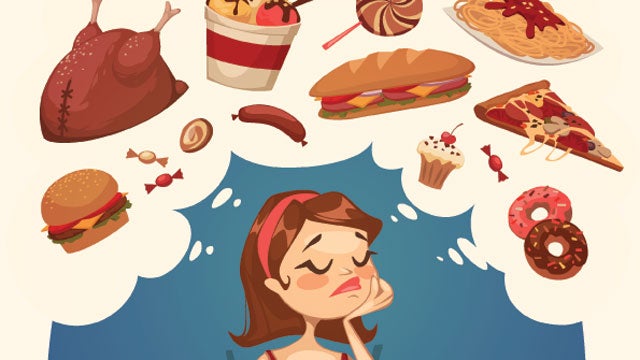CONFUSED ABOUT WHAT TO EAT THESE DAYS? Join the club. In the last decade, America has been sucked into a maelstrom of food craziness: misinformation, disinformation, product-choice overload, gale-force marketing, and Category 5 fad diets. Never before has there been so much food that’s “supposed to be good for you” (to echo a once popular cereal commercial) but, frankly, isn’tÔÇöor at least not in the quantities we consume.
Plate Tectonics
Dig into the world of delicious, nutritious eats, so you can feel great, play hard, live longerÔÇöand go for the gusto. ░ń│ó▒§░ń░ş╠ř▒ßĚíŞÚĚí┬áfor the full guide. Processed foods can lead to overeating, vitamin deficiency, diminished athletic performance, impeded mental sharpness, and, in some cases, health problems.
Processed foods can lead to overeating, vitamin deficiency, diminished athletic performance, impeded mental sharpness, and, in some cases, health problems.║┌┴¤│ď╣¤═° aims to set the record straight: Eating for fitness, health, energy, and longevity isn’t all that complicated. In a perfect world, we would all be shopping at the farmers’ market and sitting down to balanced meals of wholesome foods sustainably produced and deliciously prepared. Alas, in the real world our table tends to get set with far less inspiring fareÔÇöenergy-dense and nutrient-barren processed foods that lead to overeating, vitamin deficiency, diminished athletic performance, impeded mental sharpness, and, in some cases, health problems. We’re pleased to present the solution: The ║┌┴¤│ď╣¤═° Guide to Food.
Our seven-step plan will help you transcend the shrink-wrapped, trans-fatted, and sugar-spiked, launching willing gastronauts into a whole new stratosphere of culinary enlightenment. The program isn’t designed for crash weight loss. Rather, we map out a route that will simultaneously clean and rev up your engine; shedding poundsÔÇöif that’s your goalÔÇöis just one of the many fringe benefits. Think of this as core training at the molecular level, a systematic and lifelong path to nutritional empowerment, one that redirects energy toward eating purposefully, appreciatively, creatively, and, most of all, with satisfaction. Ready to go? OK, but first, heed this advice: Stop thinking about your diet and start thinking about food.
Everything You Know About Food Is Wrong
Say goodbye to the food pyramid.
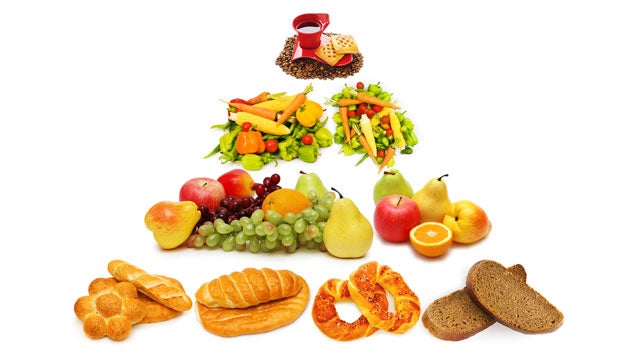
Active persons are going to reap the most benefit if their allotment of carbs, protein, and fat ranges between the 40-30-30 ratio prescribed by the Zone diet and the 65-15-20 supported by many sports nutritionists.
food guide
 Know how to differentiate good fats from bad. (Tip: If it’s processed, generally look for something else.)
Know how to differentiate good fats from bad. (Tip: If it’s processed, generally look for something else.)THE USDA, THE FEDERAL AGENCY that develops guidelines on how to eat, has relied on its ubiquitous Food Guide Pyramid to spread nutrition information to the public for more than a decade. Since its inception, however, many nutrition experts have questioned how well the tool has worked. “The pyramid needs a drastic revision,” says Michael Jacobson, executive director of the Center for Science in the Public Interest.
Why? Many feel that the food pyramid isn’t dramatically flawed; it’s just dangerously vague. It places foods into rigid categories, with “bread, cereals, rice, and pasta” at the bottom, fruits and vegetables on the next tier, meat and dairy on the next, and sweets at the top. The pyramid tells you how many servings of each group you should be getting daily, but not the size of those servings. As a result, some of us have been eating way too much. Even more problematic is the overwhelming array of products that seem to fall loosely into the pyramid categories. We’re encouraged to make breads, cereals, rice, and pastas the foundation of our diet, but such thin information hardly helps us make an informed decision in the store. These issues might be addressed when the pyramid gets overhauled in early 2005. In the meantime, allow us to help you out.
We’ll spare you a graduate seminar in nutrition, but you won’t get very far on your food journey without knowing a few basics about macronutrientsÔÇöthat is, carbohydrates, fat, and protein. First and foremost, you need all three, every day, in appropriate proportions. The trouble comes in differentiating good carbs, fats, and protein from bad. Organic spelt bread, for example, is a carbohydrate. But so is Cap’n Crunch. Most ice cream is high in fat; so is olive oil. Salmon has protein; so does a Big Mac. And these are the easiest to distinguish. It’s not the macronutrients that are the problem; it’s our understanding and use of them.
The optimal ratio of macronutrients is unique for each individual, but here are some road rules to steer you back into balance. The body uses carbohydrates as its primary fuel source, meaning it burns carbs before it burns fat or protein. The more active you are, the more carbohydrates you need. The higher the quality of those carbsÔÇöthink carrot sticks or cantaloupeÔÇöthe more you’ll benefit from them in terms of vitamin richness and long-lasting energy.
The problem is, many carbs are processed to the point where much of their nutritional benefit has been vaporized, as in many popular breakfast cereals. Overprocessed carbs are stripped of fibrous hulls, ground into microfine particles, then packed with sugar, salt, and hydrogenated fat for taste, and preservatives for shelf life. These carbs break down quickly in the bloodstream, causing a spike in insulinÔÇöan effect known as the glycemic responseÔÇöwhich turns carbs into fat in greater proportions and also leaves you hungrier sooner. The glycemic response caused by a given food is measured by its glycemic index. You can find an extensive listing of foods at to help you distinguish between good and bad starches and take better dietary control of blood-sugar fluctuations. Get to know the list; it’s a key part of eating better.
As for protein and fat, we need those in smaller quantities, though they are still essential for our health and fitness. The best benefits are delivered if your total-calorie intake shakes out somewhere between the 40-30-30 carb-protein-fat ratio advocated by Dr. Barry Sears in his Zone diet and the roughly 65-15-20 carb-protein-fat allocation supported by many nutritionists. The specific numbers, however, are less important than eating mostly good carbs, with some protein and fats to round out the calories.
Your homework assignment, then, is to familiarize yourself with both the glycemic index and the wide variety of foodsÔÇöboth good and badÔÇöthat fall into the carbohydrate, protein, and fat categories. (For a few examples, see “Mean Cuisine,”) Once you can look at a plateÔÇöor a dayÔÇöof food and identify the relevant macronutrient ratios, you’re on your way to optimal health.
Revenge of the Farmers’ Market
Believe it or not, many large manufacturers don’t place your health and fitness at the top of their priority list.
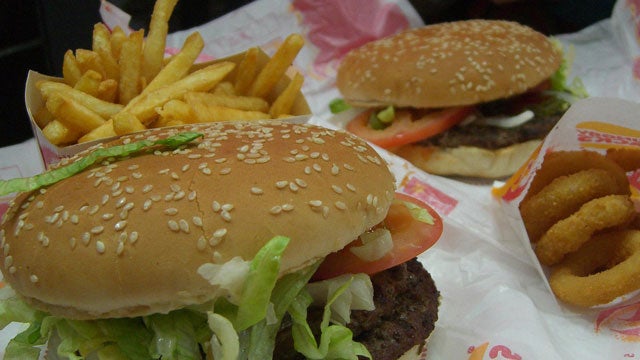
Shop the perimeter of the store for produce, whole-grain baked goods, deli, and dairy items. At the checkout lane, look at your basket. What’s the ratio of whole to processed foods? Strive to make two-thirds or more whole foods.
food guide
 Be sure your energy intake isn’t empty of nutrients. When you feed yourself, aim to help yourself.
Be sure your energy intake isn’t empty of nutrients. When you feed yourself, aim to help yourself.food guide
 Strive to make two-thirds of your groceries whole foods rather than processed.
Strive to make two-thirds of your groceries whole foods rather than processed.DEEP DOWN, WE ALL really know what to eat, don’t we? Let’s talk specifics: fresh fruits and vegetables, grains, nuts, olive oil, lean meat and poultry, salmon and other healthy fishÔÇöput simply, whole foods that have gone through no or minimal processing. Simple enough. Well, maybe not.
“The key lies in bridging the gap between knowing and doing,” says Ellie Krieger, a New YorkÔÇôbased nutritionist anauthor of the forthcoming (Clarkson Potter, February 2005).
Why are whole foods so much better for us, and how do we get more of them into our gut? Nutritionists like to talk about food in terms of energy. “Energy intake” is nutri-speak for eating. “Energy output” refers to activity, like mountain biking or running to catch a flight. With relatively minor variation, the quality and volume of intake and output determine our physical makeup.
Many processed foods are “energy-dense,” because the added sugar and lack of water or fiber spikes the glycemic response described earlier. We’re going to push you to eat whole foods that are less energy-denseÔÇöfor a list, see , by Bradley and Craig Willcox (Clarkson Potter)ÔÇöand foods that fall lower on the GI scale. You’re not eliminating all items with high GI ranking, like, say, bananas and baked potatoes, just balancing them with food across the range. Herein lies one of our biggest challenges.
Because so much of our food behavior is driven by convenience, price, and taste, we are largely at the mercy of the marketplace. “People don’t make choices about what they bring into their households in a vacuum,” says Marion Nestle, professor of nutrition at New York University and author of (University of California Press), a book about the food industry and federal nutrition policy. “Those choices are manipulated by $34 billion worth of food and beverage marketing.”
Believe it or not, many large manufacturers don’t place your health and fitness at the top of their priority list. The good news is that never before have so many wellness entrepreneurs been working as hard to make healthy food tasty, inexpensive, and accessible. Have you been to your local co-op lately? It may not be the dimly lit, leaflet-festooned hovel you remember. More likely, it’s modeled (or remodeled) after a specialty grocer like Whole Foods, Wild Oats, or the Harris-Teeter chain in the SoutheastÔÇöveritable chapels illuminated with reverence for the harvest of the earth.
This burgeoning sector may be best illustrated by the rise of the farmers’ market. According to the latest USDA figures, their numbers increased 79 percent between 1994 and 2002. Markets are now fixtures in more than 3,100 locations across the U.S. “When people go to a farmers’ market and actually meet the person who grew their food, and when they take their kids as a way to spend time with their familyÔÇöthat becomes part of the quality of life many Americans feel they’re losing,” says Anna Lapp├ę, co-author, with her mother, Frances Moore Lapp├ę, of (Jeremy P. Tarcher), a book about forthcoming food movements and a follow-up to the 1970s bestseller . “Once you experience that, you lose the desire to shop any other way.”
Which isn’t to say you can’t get everything you need at the nearby megastore; you just have to be a little more savvy about how you do it. Try shopping the perimeter of the store, where you’ll find produce, whole-grain baked goods, deli, and dairy itemsÔÇöeverything you need for optimum nutrition. As you head to the checkout lane, look at your basket: What’s the ratio of whole to processed foods? Strive to make at least two-thirds whole foods.
Eating For All-Day Drive
Think of eating the way you think about fitness.
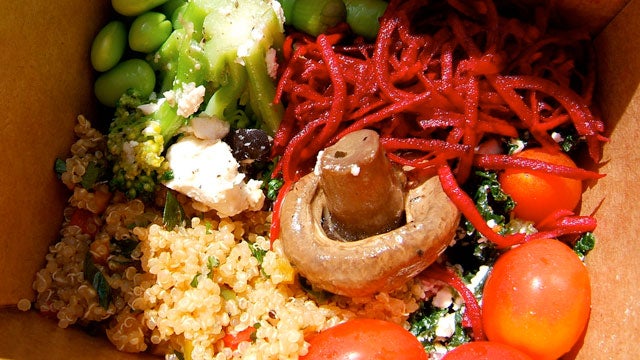
food guide
 Treat your diet as you would any routine: a system of healthful habits that require diligent pursuit before they become second-nature.
Treat your diet as you would any routine: a system of healthful habits that require diligent pursuit before they become second-nature.FAMILY, WORK, WORKOUTS, WEEKEND ROAD TRIPS… Who has time to cook? Problem is, when we succumb to spontaneous eating, we tend to get flushed down the river of poor nutrition. If your goal is to take control of what’s going down your chute, then you should approach eating the same way you’d approach a fitness goal. You won’t finish a marathon in very good style by training when you feel like it; you set up a schedule and stick to it. With time, the routine gets easier and more rewarding.
You may not need or want to plan a schedule around “three squares a day.” Like it or not, breakfast, lunch, and dinner aren’t what they used to be during our collective past as an agrarian society, when we would burn off giant meals through a lot of hard labor in the fields. These days, many coaches, trainers, and nutritionists are pushing more frequent, smaller, and smarter meals and snacks. This will not only help smooth out the metabolic peaks and valleys you experience as a meal or snack spikes your energy level, but will also keep your appetite (and potential caloric bender) from raging out of control and help you introduce smarter food into your day.
There are plenty of ways to make your meal plan convenient, appealing, and customized to fit your lifestyle. If you’re too wiped at the end of a workday to cook, try preparing several meals (lasagna, soups, and stews work well) over the weekend and refrigerate them for quick microwave or stovetop preparation. Keep broccoli, cauliflower, and brussels sprouts in the freezer for a quick heat-and-eat. The idea is to avoid desperately grabbing whatever’s cheap and easy. “People make mistakes when they reach for something out of convenience,” says Chris Carmichael, Lance Armstrong’s fitness coach and author of the bestseller (Putnam).
We’re not suggesting you throw out old eating habits overnight and replace them with something strange and complicated. Instead, think of this as a humble beginning, a platform from which you can pursue your goals, whether it’s a podium finish, a better bod, or more energy for work and play. Remain a passive eater andÔÇöpun fully intendedÔÇöyou’re toast. Follow the next seven steps, however, and you’ll thrive.
The Path to Food Empowerment
It’s paved with variety, sociability, self-awarenessÔÇöand, yes, temptation.
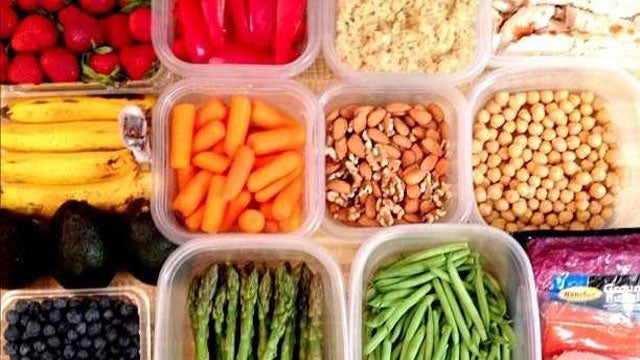
Diversity is beautiful: Buy food in a variety of textures and colors because they contain more vitamins and minerals, and set up a pantry of staplesÔÇöolive oil, tamari, wild rice, sea salt, a variety of legumes.
food guide
 Think about what you do during the day and choose your energy intake respectively. On your feet a lot? Steer toward high-quality carbs.
Think about what you do during the day and choose your energy intake respectively. On your feet a lot? Steer toward high-quality carbs.food guide
 Whole foods spoil more quickly than processed; when you shop, think about the short-term without compromising health for convenience.
Whole foods spoil more quickly than processed; when you shop, think about the short-term without compromising health for convenience.Step One: Keep a Food Diary
Buy a notepad and, for two weeks, record everythingÔÇöand we mean everythingÔÇöyou eat each day. At the end of the first week, mark items that are a simple preparation of fresh food as ff. Mark crackers, cookies, ice cream, and other sweet snacks and desserts as ed, for “energy-dense.” What’s the ratio? When are you eating? (Ideally, your calories should be consumed evenly throughout the day.) Do more than four hours elapse between meals and snacks? (This lag may promote overeating.) During the second week, start checking out ingredients in the products you buy. Can you find items you like with a smaller number of ingredients, and beverages that aren’t loaded with sugar or high-fructose corn syrup? After week two, assess what’s changed from week one.
Step Two: Plan a Meal Schedule
Eating well requires planning a weekly menu and doing the bulk of your shopping, and even some cooking, ahead of time, like on a weekend afternoon. Write your eating schedule down in your daily planner, the same way you’d schedule a workout or business appointment. Now make a shopping list that balances carbs, protein, and fat. The more active you areÔÇöWorking out frequently? On your feet all day?ÔÇöthe more that ratio should lean toward high-quality carbohydrates like whole grains, fruits, and vegetables. In your plan, include specific time-saving steps, like roasting three pans of, say, red potatoes with rosemary, or carrots and parsnips tossed in olive oil, and storing them in airtight containers in the fridge. Now write down what you’ll be eating and snacking on through your day: soup or chili, pineapple slices, a bagel with cream cheese, an apple, homemade zucchini bread. Like to eat out a few times a week? Great. Build that into the plan, but steer toward restaurants with a menu that’s fresh and local.
Step Three: Explore New Food Sources
Sitting down to produce, whole grains, meat, and fish at every meal will likely require several trips to a store or market during the week, since foods without preservatives can spoil quickly. Get in the mind-set of shopping for natural foods in a variety of textures and colors. (Coloration is a reflection of different vitamins and minerals.) Diversify your provisions by buying a different vegetable or fruit every week; ask the local farmer or produce manager how to eat a pomegranate, how to slice a mango, or how to saut├ę Swiss chard. “It takes time to shift the places where you shop and how you think about food,” says Anne Lapp├ę. “But we spend a lot of hours at the gym trying to lose the weight we put on eating unhealthy foods. Think how much time you’d save if you didn’t have to do that.”
Step Four: Build Your Cooking Skills
Take a class, or at least get a good cookbook. Need some suggestions? , by Mark Bittman (Wiley, $35); , by James Peterson (Artisan, $25); or , edited by Ruth Reichl (Houghton Mifflin, $40). Basic cooking includes learning to chop and carve produce and cuts of meat and learning to steam, sear, roast, and grill. Now you can learn more sophisticated techniquesÔÇömaking a simple sauce from oil, shallots, butter, and wine; making fresh salsa; using herbs and spices; making a simple soup from roasted winter vegetables. Invest in decent knives, pans, and bowls. Finally, set up a pantry of staples, like tamari, olive oil, sea salt, legumes, and wild rice, so that every recipe doesn’t require a separate run to the market. “If all you have in your refrigerator is ketchup and beer,” says nutritionist Ellie Krieger, “that’s all you’re going to eat.”
Step Five: Use the Real Stuff
Foods labeled “low-carb” can cause trouble if you’re eating twice as much to feel satisfied. Likewise “low-fat.” It may even be preferable to use real butter or cream in a sauce than to drown a dish in low-fat substitutes in order to try to match the taste. That said, if a recipe calls for saut├ęing with butter, try using olive oil instead. Make your own salad dressingÔÇösimple olive oil, balsamic vinegar, and Dijon mustard whisked together is better than most prepared dressings. Remember the glycemic index? Start swapping foods with a high GI rating for those with a low one. For example, try boiled new potatoes instead of baked russets; instead of sticky or white rice, try wild or parboiled rice; replace cream soups with broth-based soups; instead of breads, eat greens. Enjoy cream-cheese dips? Try bean dips like hummus. Also, have an occasional treatÔÇösubbing in, say, filet mignon for a flank steak.
Step Six: Host a Meal
It’s no accident that the bulk of bad eating happens in solitary or socially deficient settings. Put it this way: Friends don’t let friends serve frozen pizza. Take your new skills and put them to work hosting a mealÔÇöfor a date, pals, or family. “We are tribal animals, and eating for human beings is a social activity,” says cookbook author and Gourmet editor Ruth Reichl. “As you start to understand the pace of eating sociallyÔÇöwhich is much slowerÔÇöyou eat less, and it’s more satisfying.”
Step Seven: Plant a Garden
Time to close the loop, and few things are more empowering than sitting down to food you grew from a seedling. Live in a city? Try containers on your fire escape, windowsill, or rooftop. Even an herb garden above your sink is a great start. Making the connection between the work that goes into something as simple as a tomato and the flavor it offers on your plate will change the way you view produceÔÇöand food in generalÔÇöforever.


